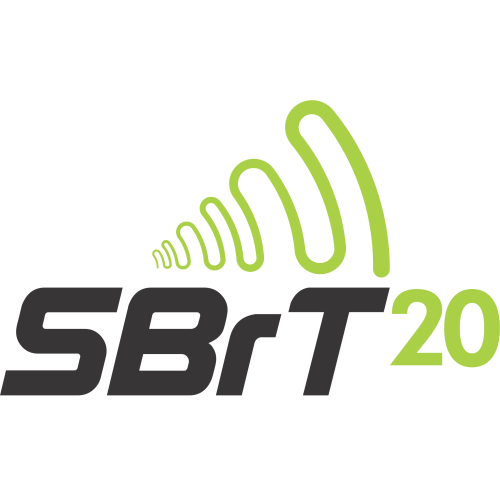
XXXVIII Simpósio Brasileiro de Telecomunicações e Processamento de Sinais

On the Impact of the Number of Interferers and Channel Estimation Errors in SC-FDE SIMO IB-DFE Systems
Rogério Pereira, Bruno Chang, Carlos Aurélio Faria da Rocha, Didier Le Ruyet
DOI: 10.14209/SBRT.2020.1570647177
Keywords:
Abstract
In this work, we analyze the effect of channel estimation errors on the bit error rate (BER) of a novel linear frequency domain iterative equalizer for SIMO single carrier systems with frequency domain equalization under the effect of multiple interferences, which takes the channel estimation errors into account in the equalization. It was found out that the proposed equalizer outperforms the iterative structure which does not take into account the channel estimation error process. Simulation results showed that this equalizer presents a better error performance when compared to its conventional version.Download

A Two-Stage Approach for Noisy-Reverberant Speech Intelligibility Improvement
Guilherme Zucatelli, Felipe Farias, Rosângela Coelho
DOI: 10.14209/SBRT.2020.1570647615
Keywords: speech intelligibility noisy-reverberant non-stationarity adaptive methods
Abstract
In this paper, a two-stage time domain technique is proposed to improve intelligibility of speech signals under noisy-reverberant conditions. In this method, the NNESE and ARAnsd methods are jointly taken into account to mitigate the effects of noise and reverberation separately. Additionally, the resulting approach is adaptive in the sense that no prior knowledge of speech statistics or room information is required. Two intelligibility measures (ASII ST and ESII) are used for objective evaluation. The results show that the proposed two-stage scheme leads to a higher intelligibility improvement when compared to competing methods, specially for low SNR values. Furthermore, the PESQ and the updated version of the SRMR quality measure (SRMRnorm ) demonstrate that the proposed technique also attains quality improvement.Download
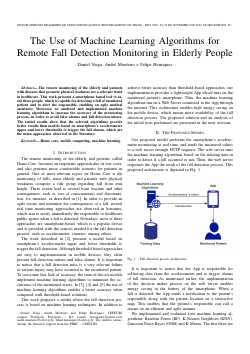
The Use of Machine Learning Algorithms for Remote Fall Detection Monitoring in Elderly People
André Felipe Monteiro, Felipe da Rocha Henriques, Daniel V Antunes
DOI: 10.14209/SBRT.2020.1570647830
Keywords: Home Care Mobile Computing Machine Learning
Abstract
The remote monitoring of the elderly and patients with diseases that promote physical weakness are a relevant trend in healthcare. This work presents a smartphone based tool to assist these people, which is capable for detecting a fall of monitored patient and to alert the responsible, enabling an agile medical assistance. Moreover, we analyzed and implemented machine learning algorithms to increase the accuracy of the monitoring process, in order to avoid false alarms and fall detection misses. The initial results show that the selected algorithms provide better results than models based on smartphone's accelerometer upper and lower thresholds to trigger the fall alarms, which are the main approaches observed in the literature.Download
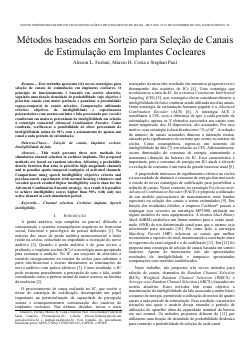
Métodos baseados em Sorteio para Seleção de Canais de Estimulação em Implantes Cocleares
Alisson L Furlani, Marcio Costa, Stephan Paul
DOI: 10.14209/SBRT.2020.1570647878
Keywords: Channel selection Cochlear implant Speech intelligibility
Abstract
This work presents three new methods for stimulation channel selection in cochlear implants. The proposed methods are based on random selection, following a probability density function that aims to prioritize high magnitude channels and to penalize spatio-temporal contiguity of activated channels. Comparisons using speech intelligibility objective criteria and psychoacoustic experiments with normal hearing volunteers and vocoded speech resulted higher intelligibility scores than for the Advanced Combination Encoder strategy. As a result, it is possible to achieve intelligibility scores higher than 90% with only one active channel at each stimulation period.Download
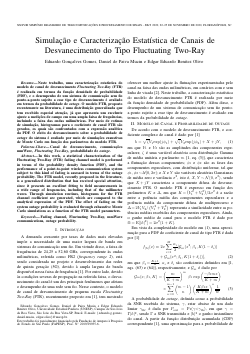
Simulação e Caracterização Estatística de Canais de Desvanecimento do Tipo Fluctuating Two-Ray
Eduardo Gonçalves Gomes, Daniel P Mucin, Edgar Eduardo Benitez Olivo
DOI: 10.14209/SBRT.2020.1570648016
Keywords: comunicações mmWave Fluctuating Two-Ray canal de desvanecimento probabilidade de outage
Abstract
In this work, a statistical characterization of the Fluctuating Two-Ray (FTR) fading channel model is performed in terms of the probability density function (PDF), and the performance of a point-to-point wireless communication system subject to this kind of fading is assessed in terms of the outage probability. The FTR model, recently proposed in the literature, is a generalized distribution that has received special attention, since it presents an excellent fitting to field measurements in a wide range of frequencies, including that of the millimeter waves. Through simulation routines, histograms for the FTR channel coefficient are generated, which are compared to the analytical expression of the PDF. The effect of fading on the system outage probability is evaluated through exhaustive Monte Carlo simulations as a function of the FTR model parameters.Download

Energy Analysis in Cooperative Machine-Type Communications with Reconfigurable RF Transceivers
Edson Leonardo dos Santos, Andre Mariano, Glauber Brante, Richard Demo Souza
DOI: 10.14209/SBRT.2020.1570648622
Keywords: Energy efficiency Cooperative communications Reconfigurable RF transceivers
Abstract
In this paper, we consider reconfigurable RF transceivers in cooperative communications towards improving the energy efficiency. More specifically, we combine different operating modes of the power amplifier (PA) and the low noise amplifier (LNA). Our results show that the proper optimization of these modes combined with cooperative relaying may be considerably more energy efficient than non-cooperative schemes with multiple antennas over moderate and long distances. Results also show that most reconfigurability depends on the relay node, since it only acts when necessary.Download
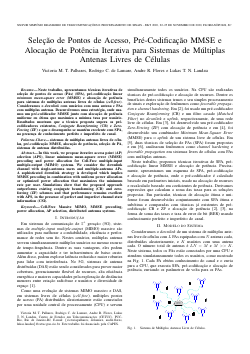
Seleção de Pontos de Acesso, Pré-Codificação MMSE e Alocação de Potência Iterativa para Sistemas de Múltiplas Antenas Livres de Células
Victoria M. T. Palhares, Rodrigo C. de Lamare, Andre R. Flores, Lukas T N Landau
DOI: 10.14209/SBRT.2020.1570648634
Keywords: Cell-Free Massive MIMO MMSE precoding power allocation AP selection
Abstract
In this work, we propose iterative access point (AP) selection (APS), linear minimum mean-square error (MMSE) precoding and power allocation for Cell-Free multiple-input multiple-output (MIMO) systems. We consider the downlink channel with single-antenna users and multiple-antenna APs. A sophisticated downlink strategy is developed which implies MMSE precoding in combination with uniform power allocation or optimized power allocation that maximizes the minimum rate per user. Simulations show that the proposed approach outperforms existing conjugate beamforming (CB) and zero-forcing (ZF) schemes and that performance remains excellent with APS, in the presence of perfect and imperfect channel state information (CSI).Download
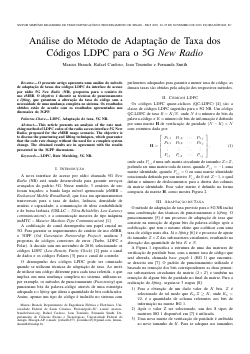
Análise do Método de Adaptação de Taxa dos Códigos LDPC para o 5G New Radio
Marcus Venicius Lau Branch, Rafael Correa Cardoso, J. Tourinho, Fernanda Smith
DOI: 10.14209/SBRT.2020.1570648660
Keywords: LDPC Adaptação de taxa 5G NR
Abstract
This article presents an analysis of the rate matching method of LDPC codes of the radio access interface 5G New Radio, proposed for the eMBB usage scenario. The objective is to discuss the puncturing and lifting techniques, which guarantee that the code rate change without the need for a complete system change. The obtained results are in agreement with the results presented in the 3GPP discussions.Download

Avaliação e Comparação do FEM e dos Elementos de Aresta em um Problema Eletromagnético Dinâmico
Lucas F. Lopes, Ramon Soares
DOI: 10.14209/SBRT.2020.1570648669
Keywords: Elementos Finitos FEM Autovalor Elementos de Aresta
Abstract
Neste trabalho, o método dos Elementos Finitos e dos Elementos de Aresta avaliam um problema de autovalor em duas dimensões. Os algoritmos construídos apresentam soluções numéricas para um guia de ondas retangular, constituído de um condutor elétrico perfeito com vácuo no interior. Os resultados numéricos obtidos, com ambos os métodos, são comparados às soluções analíticas, sendo determinado erro relativo e a taxa de convergências de cada método. Os algoritmos construídos tiveram o tempo de processamento determinados.Download

Otimização Bioinspirada para Eficiência Energética em Redes Móveis Heterogêneas
Jessica Soares, Hugo Pereira Kuribayashi, Carlos Renato Francês, Warley Junior
DOI: 10.14209/SBRT.2020.1570648680
Keywords: HetNet Algoritmo Genético Eficiência Energética
Abstract
Both capacity and energy efficiency are crucial for next-generation wireless networks. Hence, due to the dense deployment of BSs in HetNets, consumption is 60% to 80% of the total energy, causing steep costs. Therefore, industry and researchers are working to reduce the energy consumption of HetNets. In order to increase energy efficiency, guaranteeing the QoS requirements, we propose the use of a genetic algorithm with BS suspension mechanisms. The results of the simulations demonstrate that the proposed algorithm has a better performance in terms of energy efficiency compared to the user association mechanism based only on maximum SINR.Download